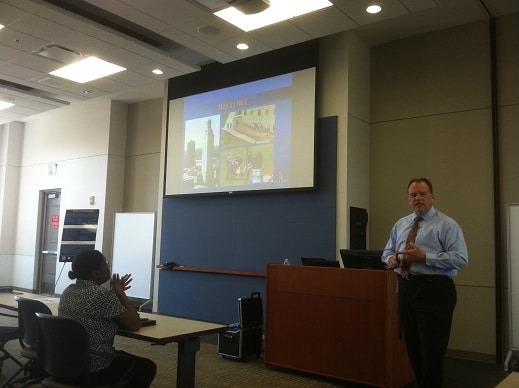Controversial Student Training Includes Taking On Gunmen
 Birmingham — Jonesboro, Columbine, Virginia Tech. Those names and others have become tragic shorthand for school shootings. Today, when there’s a threat, the typical lockdown plan that most schools follow is sound the alarm, call police, lock doors, and stay put. But a growing number of schools are adopting controversial training that includes how to fight back against a gunman. WBHM’s Southern Education Desk reporter Dan Carsen has the story:
Birmingham — Jonesboro, Columbine, Virginia Tech. Those names and others have become tragic shorthand for school shootings. Today, when there’s a threat, the typical lockdown plan that most schools follow is sound the alarm, call police, lock doors, and stay put. But a growing number of schools are adopting controversial training that includes how to fight back against a gunman. WBHM’s Southern Education Desk reporter Dan Carsen has the story:
Across the country, schools have developed a fairly typical lockdown procedure when there’s a threat: sound the alarm, call police, lock doors and stay put.
That standard plan is meant to minimize chaos so police arriving on the scene don’t shoot the wrong people. Students practice following directions, getting into classrooms, and essentially, waiting.
But some security experts think that kind of drilling is inadequate and may even be dangerous. A growing number of schools are now adopting controversial training that includes a different type of response — how to fight back against a gunman.
Beyond Lockdown And Wait
Greg Crane, a former teacher and SWAT officer, notes that even trained police officers miss roughly three-quarters of their shots fired in the line of duty. In contrast, he says, school shooters “don’t miss at that high a rate. In fact, they almost hit at that high a rate.”
He goes on: “[Gunman Seung-Hui] Cho at Virginia Tech, he was at over a 100-to-1 numerical disadvantage. One person should not be able to do what these single shooters are able to do.”
They are able to hit so many people, he says, because staff and students are just too easy to shoot. “We’ve conditioned them to go sit in a corner, go sit under a table.”
So Crane developed a training program that teaches potential victims to make themselves harder targets — and that includes ways to fight back. He dubbed the program “ALICE training”: alert, lockdown, inform, counter, evacuate.
“We don’t tell [students and staff] what to do. We tell them what they can do,” Crane says. “Ultimately, they’re going to be the ones experiencing this danger, and we want them to be the ones to decide, ‘What is it that I can do that will increase my chance of survival?'”
Crane and other ALICE proponents want to empower the people in a shooting situation — even children — to make those life-and-death decisions. At least 1.6 million people in almost 300 school systems, from elementary schools to colleges and universities, have had ALICE training. Crane says he’s even taught an age-appropriate version to kindergarteners.
‘Throwing, Screaming, Yelling’
Auburn University in Alabama is a more typical setting for ALICE training. On a recent afternoon, emergency manager Chance Corbett is analyzing school shootings for about 30 staff and students.
Corbett points out huge differences in room-to-room survival rates based on what occupants did. At Virginia Tech, a professor was killed, but not before he saved students’ lives by getting them to jump out windows.
In one school building, Corbett says, 12 students were killed in one room and eight in another. But in a classroom where students barricaded the door, “it was zero,” he says. “They made a decision that day, it saved their lives. How many of you want to be in that classroom?”
ALICE teaches potential victims “how to barricade, how to lock down, how to run,” Corbett says. And while he says escape is always best, “when it gets to the point that [the shooters] are there to do the harm, do you really want your kid just to hide under the desk?”

Corbett says “countering,” or fighting back, is a last resort, but he feels strongly that people should know how.
He illustrates one “counter” technique with a drill using tennis balls, showing that shooters can’t help but look at flying objects. That can buy time to flee, or to charge.
Corbett also stresses the need to work together.
“Teamwork. Strength in numbers, guys. You don’t want two things going at his head, you want 34 things going at his head,” Corbett says. “You’re gonna be fighting, throwing, screaming, yelling and swarming, getting out of the way, moving.”
Some other tips: Block the view into the room. Use belts, purse straps, or furniture to seal doors that don’t lock or open outward. Silence your cell phones. And if you manage to overpower a shooter, put the gun under a flipped trash can and sit on it so police charging into a dangerous scene don’t shoot you.

A Controversial Approach
ALICE supporters often quote examples of unarmed people stopping shooters. Even so, not everyone thinks it’s a good approach.
“Most middle-school kids can’t decide between chicken nuggets and pizza for lunch,” says school security consultant and writer Ken Trump. “To think that we’re gonna put that liability and responsibility in the hands of a seventh-grader is insane.”
Many parents feel the same way. Greg Crane’s hometown of Burleson, Texas, was the first school district in the country to try ALICE. Some parents supported it, but others revolted and the system pulled the plug. An Alabama district recently started ALICE and is in the middle of a similar controversy.
Trump says the issue forces parents to confront a troubling question: Would you want your child leading the charge against an armed attacker?
The number of schools using ALICE training “may continue to grow,” Trump says, “until the first child who jumps up at an armed intruder gets killed, and a school official has to explain. I would not want my child to be the first one dead on the classroom floor.”
But school policy analyst Trisha Powell Crain sees ALICE training as part of a shift toward more active resistance in crime situations. Before Sept. 11, 2001, Crain says, passengers were advised to comply with hijackers. Self-defense instructors used to tell women to go limp to survive a rape. Today, she and others say, experts have changed their thinking about how potential victims should respond.
And Crain, a mother of two college students and one high school student, says some parents are willing to accept the risk the ALICE method might pose to students — and she’s one of them:
“I would be proud of them if they stepped up and tried to end the shooting. It’s just tragic. It’s tough to think about. But if your child helped save lives in the process, then yes, that’s acceptable.”
Light from satellites will ruin majority of some space telescope images, study says
Astronomers have long been concerned about reflections from satellites showing up in images taken by telescopes and other scientific instruments.
Defense Department is reviewing boat strike video for possible release, Hegseth says
In a speech on Saturday, Defense Secretary Pete Hegseth defended the strikes, saying: "President Trump can and will take decisive military action as he sees fit to defend our nation's interests."
Bama, Miami in, Notre Dame out and Indiana No. 1 in College Football Playoff rankings
Nobody paying attention for the past 24 months would be surprised to see Indiana – yes, Indiana – leading the way into this year's College Football Playoff.
McLaren’s Lando Norris wins first F1 title at season-ending Abu Dhabi Grand Prix
Red Bull driver and defending champion Max Verstappen won the race with Norris placing third, which allowed Norris to finish two points ahead of Verstappen in the season-long standings.
A ban on feeding pigeons ruffles lots of feathers in Mumbai
The pigeon population has exploded — a result of people feeding the birds. For some it's a holy duty and a way to connect to nature. Critics point to health risks tied to exposure to pigeon droppings.
UN humanitarian chief: world needs to ‘wake up’ and help stop violence in Sudan
The UN's top humanitarian and emergency relief official has told NPR that the lack of attention from world leaders to the war in Sudan is the "billion dollar question".








